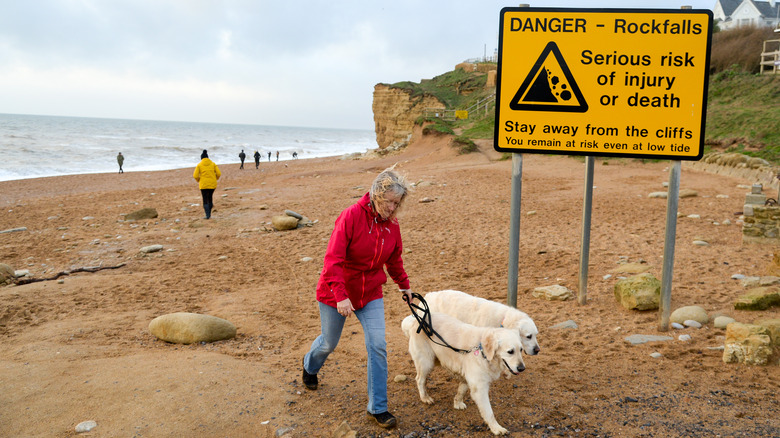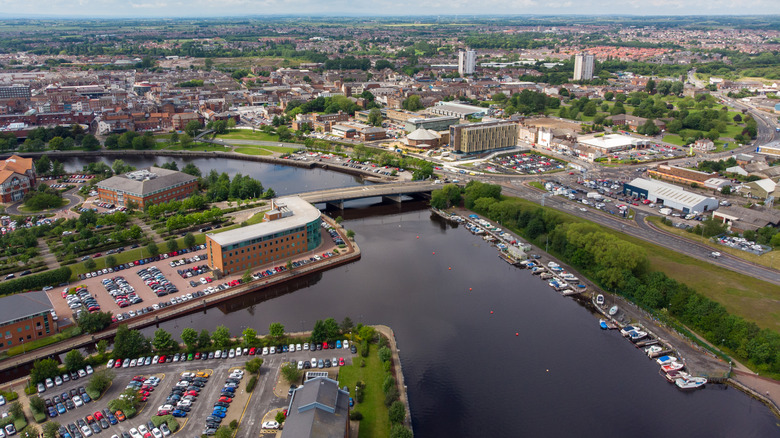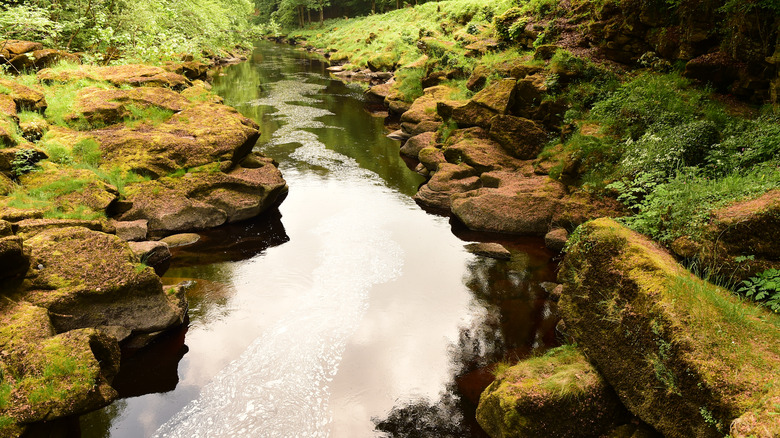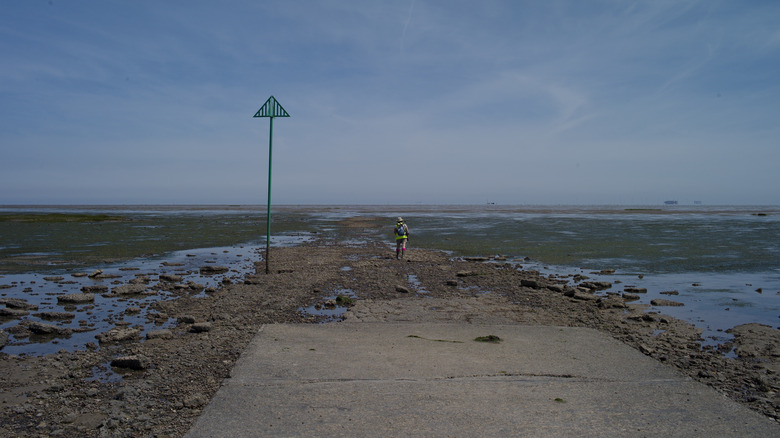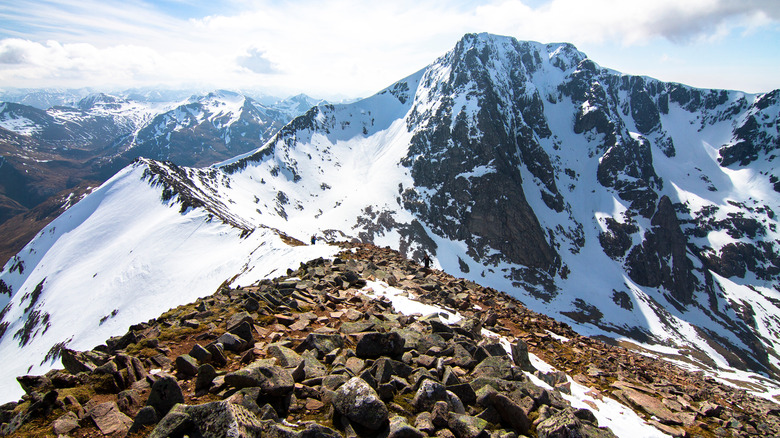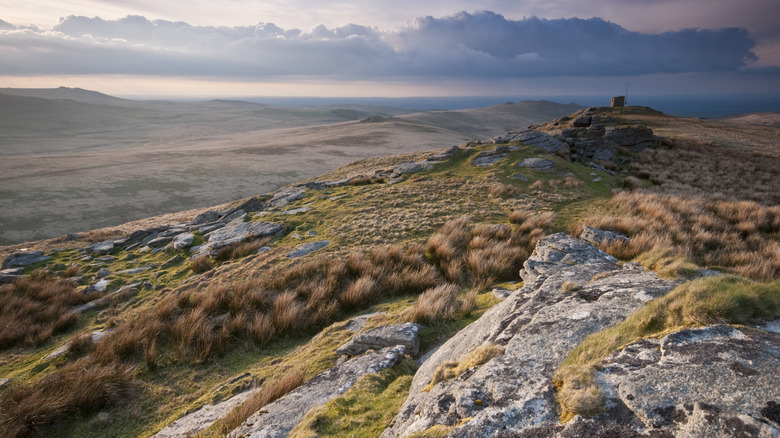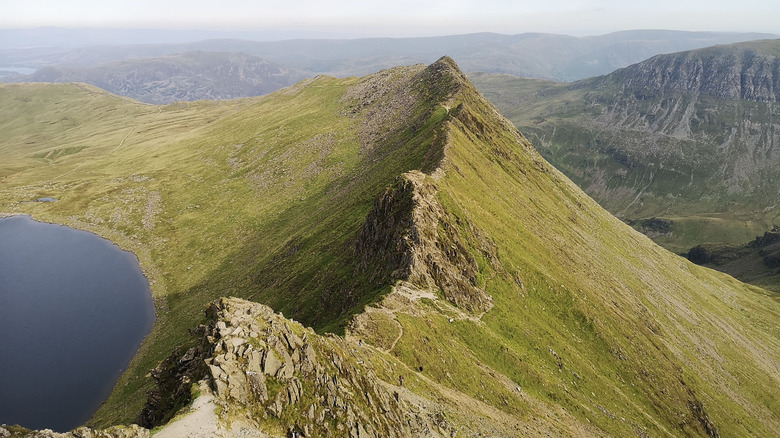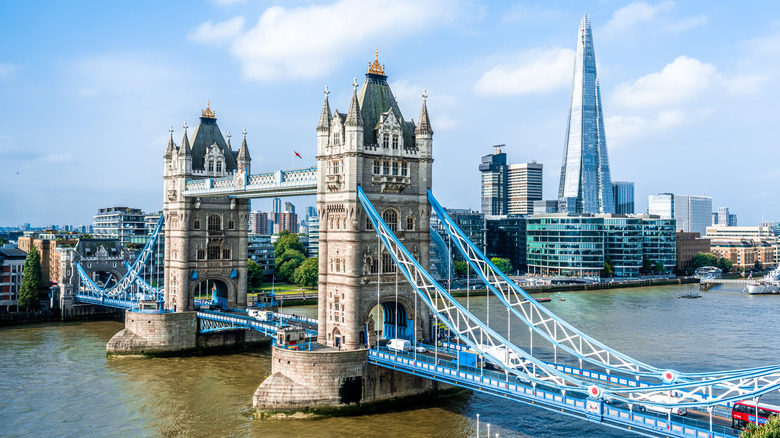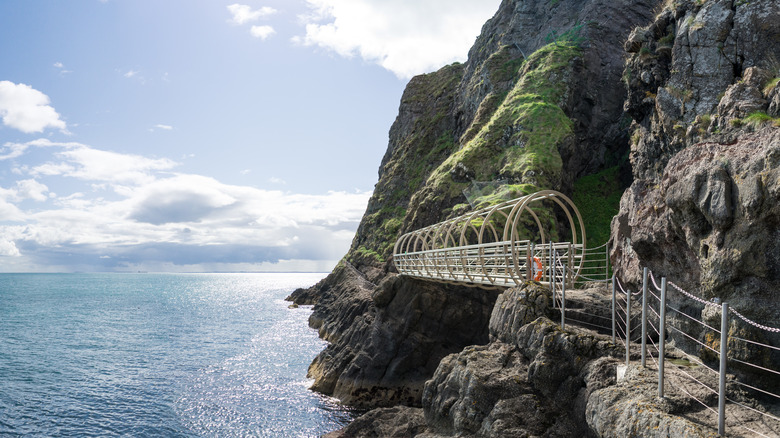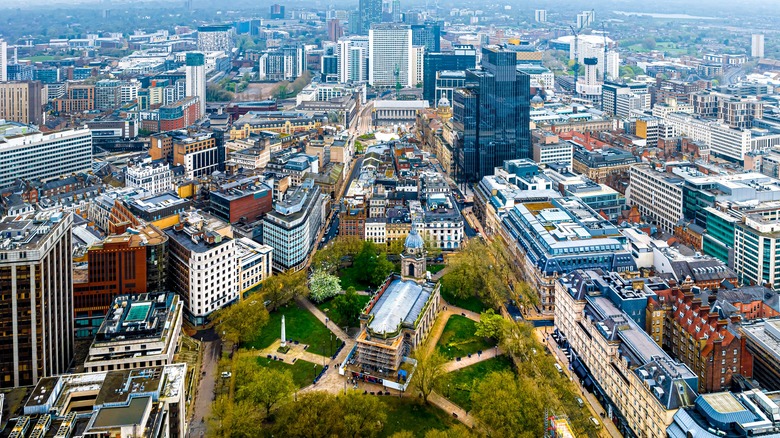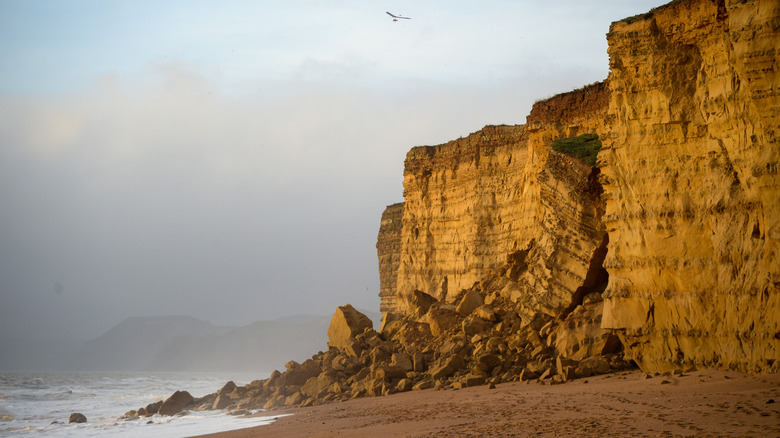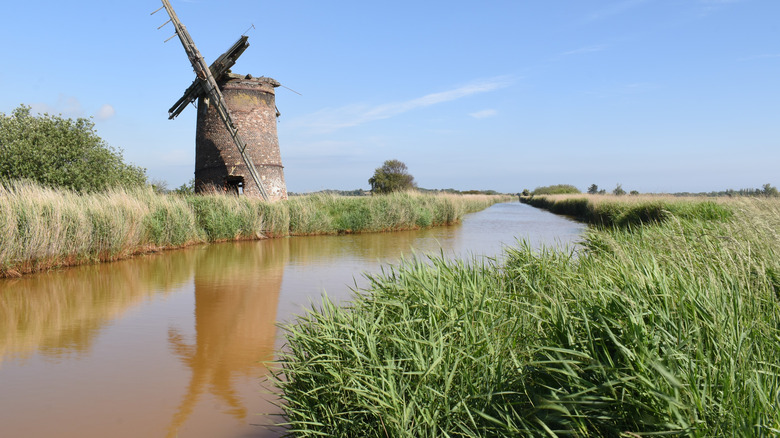Dangerous Vacation Spots In The UK
When many of us imagine vacationing in the United Kingdom, we picture the country's historic monuments, landmark tourist attractions, pastoral landscapes, and buzzy cities (top o' the mornin', London). While this verdant region is filled with extraordinary places to visit, the U.K., like many other countries, is also home to an array of dangerous vacation spots travelers should treat with caution. Whether an area is known for its criminality or perilous natural outcroppings, it's best to be vigilant when planning a vacation to certain areas of the U.K. Some places, like Cleveland in Yorkshire, have the highest crime rates in their county (per Office for National Statistics). Others are plagued by more natural hazards, like Bolton's The Strid, one of the most dangerous stretches of water in Britain. The Broomway, in Essex, is another hazardous wonder. This trail has caused fatalities for centuries.
While we're not suggesting you avoid these destinations (many of them boast attributes that outweigh the risks), we'd like to caution you about the potential hazards associated with visiting these locales. Again, this doesn't mean you shouldn't plan a trip to the United Kingdom; this stunning island country was recently deemed the world's 37th safest country, according to the 2023 Global Peace Index. As long as you're smart about where and when you travel, you're sure to have a safe and happy trip — just be wary of these dangerous vacation spots in the U.K. We chose them after studying national crime statistics, delving into research, and scouring the web for reviews and reports on treacherous places.
Cleveland, Yorkshire, England
With an astoundingly high rate of over 139 crimes per 1,000 people, Cleveland is a place you might want to miss on your next visit to the U.K. Although known for its stunning scenery (this is where you'll find the North York Moors National Park), this northeastern English county has been repeatedly deemed the most dangerous place to live in the United Kingdom (per Teesside Live).
When admiring the area's sparkling River Tees and the crashing North Sea as well as its rolling hills and dales, it's easy to think this is a beautiful and safe place to visit. Unfortunately, the most recent data released by the Office for National Statistics (ONS) confirms that this is a hazardous destination plagued by violent crime. There were over 84,200 crimes (excluding fraud) committed in the county in 2023.
Yes, there are nice parts of this area, like the Cleveland Way National Trail that runs through the resplendent park. On a 109-mile path, visitors will cross pastoral moors, a craggy coast, and a landscape blanketed in heather when visiting here. They'll also pass ancient castles and ruins along the way. It's the towns and villages you'll want to skip on your trip, like Hartlepool, Middlesbrough, and Stockton-on-Tees.
The Strid, Wharfedale, England
When looking at The Strid, you'd be forgiven for thinking it seems like a pretty benign stretch of water. Located near Bolton Abbey in Yorkshire Dales National Park, this section of the River Wharfe has been labeled the most dangerous river in Britain. Given that it is a mere 6 feet across, naïve visitors might chance a jump from one edge to the next. That will likely be the last thing they do. This is because this so-called "pinch point" of the larger river is extremely fast and flanked by slippery rocks and hidden crevices. Many people have died here, and the area is peppered with warning signs to alert visitors to the dangers. Even The New York Times dubbed this unassuming-looking stream as "England's Killer Creek."
If you want to visit this pretty spot, feel free. Just don't try to jump across or take a dip. While the water looks calm, it hides dangerous currents that run underneath the surface. Instead, admire The Strid from a safe distance and take a peaceful walk through Strid Wood. A Site of Special Scientific Interest, this is a tranquil place to visit on your vacation to England. Keep your eyes peeled for the ancient sessile oak woodland which lies on both sides of the River Wharfe. Wood Warblers, goosanders, and pied flycatchers call this area home so bring binoculars if you're an avid bird watcher.
The Broomway, Essex, England
Dubbed "the most perilous path in Britain," crossing The Broomway in Essex should only be attempted with extreme caution or better yet, not at all. Marked by a large, yellow hazard sign, this dangerous trail is responsible for the deaths of over 100 people over the past six centuries. Plus, this was the site of many more fatalities that likely passed unrecorded. Tourists can view the graves of 66 of the path's victims in Foulness Churchyard.
This treacherous path, which only appears during low tide, begins at a place called Wakering Stairs before heading east to Foulness Island. It crosses the Maplin Sands on its route. In addition to encountering sand that turns into quick-sand-like material in certain places, walkers will also be at risk of coming across a military test-firing zone. Visitors are cautioned about "unexploded objects" buried here. If that wasn't enough to turn you away, the area's mud patches that are strong enough to suck in people and animals probably should. If you're still set on walking this historic path, enlist the help of a local guide who is aware of the topography. Or take the bridge to Foulness Island instead.
Ben Nevis, Scotland
According to a study by Holidu, Ben Nevis is the U.K.'s most dangerous natural wonder with an average of three deaths each year. This may not sound like a lot, but the study claims this death rate in relation to the number of annual visitors makes it the second most dangerous natural attraction in the world behind Europe's Mont Blanc. The U.K.'s highest peak, Ben Nevis is king of the Grampian Mountains, standing stoically just under two miles outside Fort William. Don't skip this majestic site, just visit it with caution.
Dubbed "The Ben" by locals, summiting this gorgeous peak appears on many bucket lists. The mountain's North Face is a favorite with adventurous types who enjoy ice and rock climbing up craggy cliffs. Even in summer, ambling up its rocky crest is a challenging experience best completed by avid hillwalkers with a good level of fitness and navigational prowess. Planning a winter visit? The Ben is even more dangerous at this time of year, so you may want to be a climbing pro to attempt an ascent.
If you're confident in your skills, why not step things up a notch by attempting to take on the U.K.'s three tallest mountains (Ben Nevis, Scafell Pike, and Snowdon) in 24 hours? Otherwise, stick to The Mountain Track, The Ben's easiest route, and be prepared with appropriate clothing (waterproofs, layers, and hiking boots) as well as snacks, water, and a flashlight for your trek.
Dartmoor National Park, Devon, England
In addition to dangerous and quick weather changes and rocky terrain in parts, Dartmoor National Park presents another threat not found in other U.K. destinations — risks associated with frequent military training. Before visiting, hikers are warned not to touch any "unexploded ordnance anywhere on the moor." Live firings also occur in certain spots, so you must check the firing notice before visiting to ensure you're not walking in a dangerous area. In good news, many of the area's unmarked mine shafts are being capped, fenced, and marked.
Other worrisome features include the park's multitude of bogs, rivers, and streams. When the area experiences heavy rains, these can flood rapidly, making them risky to cross. Don't let this dissuade you from visiting. This National Park is a great destination for history buffs and home to the famed Dartmoor ponies. Here, you'll find southern England's largest moorlands and a variety of flora, fauna, and wildlife so captivating, that you'll forget all about any dangers. Many birds call this vast land home, as do otters, butterflies, and dormice.
Prepare yourself for a visit by wearing layers, including long sleeves, pants, gloves, a hat, waterproof shoes, and a raincoat to ensure you're protected from the weather. A map, food, water, whistle, and flashlight are other must-haves to add to your day pack. Also, check yourself for ticks after your journey as these pesky critters can climb on easily when you walk through long grasses or other vegetation.
The Lake District, England
As long as you're smart about your visit to the Lake District, you should enjoy a lovely day (or more) of exploring. A popular place to hike, there are many steep inclines, slippery rocks, sharp ridges, and rivers prone to flooding when the weather is less than ideal. The Lake District National Park is home to one of the largest and most dangerous peaks in England, Striding Edge. As noted on The Lake District's site, this third highest fell in England is "fraught with danger." It is no place for novice climbers.
More than 25 people died in this region in 2022, up from 12 fatalities in 2019. The reason this number has more than doubled has much to do with hikers being unprepared for their trek. According to a Cumbria Crack interview with Mountain Rescue Chief Richard Warren, many novice hikers embark on adventures without proper equipment or knowledge of how to navigate uncommon areas such as becks (mountain streams), mountain summits, and cavernous ravines. Paddleboarding on Ullswater, the second-largest lake in England, has also proved deadly.
Be prepared by checking weather forecasts the night before you're due to hike, packing extra food and water, wearing layers (including a waterproof coat and shoes), finding a hiking partner, and sharing your route and timing with someone so they'll be aware if you don't return on time. If you aren't comfortable risking an adventurous trek, stick to the lower routes, which involve easier walks and stunning vistas.
London, England
London is a must-visit destination for any U.K. traveler. A haven for history buffs, this landmark city is filled with iconic tourist attractions, historic monuments, world-class museums, Royal Parks, and of course, Buckingham Palace. While there are many tourist traps to avoid during your trip, this famed city boasts enough fun things to do that you could spend much more than just two days exploring its points of interest. The main downside of a London vacation, apart from the rain, is the risk of encountering a crime.
The biggest and busiest city in the U.K., London has the country's highest total crime rate, with over 900,000 crimes recorded between June 2022 and June 2023. This includes the City of London as well as Greater London's 32 boroughs. There were nearly 101 crimes reported per 1,000 people in the 2022-2023 report (per Statista), but it is worth noting that London has the largest population in the U.K. with over 9 million residents. And it's no secret that crime rates are higher in larger cities.
Still, it's important to be as vigilant when visiting London as you should in any large city. Crowded attractions attract petty criminals waiting to take advantage of unassuming tourists. The Tube (aka subway) has noticed an increase in pickpocketing, particularly at busy hubs like King's Cross St Pancras. The most popular time for Tube thefts is weekends between 5 p.m. and 8 p.m. Crowded sites like Leicester Square and Oxford Circus are also prime targets, so be vigilant.
West Yorkshire, England
Despite its lush landscape highlighted by deep valleys, vast moors, and green hills, West Yorkshire is a place you should be wary of visiting. In fact, some believe parts of this pretty region are a no-go zone. Named as the second most dangerous place to live in the U.K., this county, which includes Bradford, Wakefield, and Leeds, saw over 56 violent crimes per 1,000 people between June 2022 and June 2023, according to Churchill Support Services.
An industrial powerhouse in the Victorian era, Leeds has many attractions worth visiting, like the Royal Armories, Roundhay Park, and the well-preserved ruins of Kirkstall Abbey. It's probably best to avoid the Leeds City Center, though, especially at night. Named the second most dangerous area for crime in England and Wales (London takes the top spot), there have been a reported 1,366 crimes for every 1,000 locals. Roughly one crime occurs every 41 minutes in this area, making it home to the highest crime rate in the county (per LeedsLive). City-wide, the West Yorkshire Police reported 47,831 violent and sexual assault crimes between March 2022 and February 2023 (per Yorkshire Evening Post). Umm, no thanks.
County Antrim, Northern Ireland
It's no secret that Ireland is a cold and rainy place to visit in the U.K., but this wet weather helps create greens so vibrant that you may feel you've stepped into an Instagram filter. Northern Ireland's County Antrim is renowned for its spectacular scenery and top-rated natural attractions. This is where you'll find multiple heritage sites, including historic castles and the otherworldly Giant's Causeway, which you'll have to see to believe. Fabulous as this spot is (40,000 basalt columns line the coast), this UNESCO World Heritage Site is also one of Ireland's most dangerous tourist destinations. Many travelers have fallen on the slippery, uneven rocks, some ending up in the cold water. A rogue wave pulled a group of children into the sea in 2022.
The Gobbins Cliff Path is another must-see tourist attraction located in this gorgeous Irish locale. But beware. Although it's literally breathtaking (the whipping winds and crashing waves are natural adrenaline boosters), this unique spot is also a dangerous place to visit. Those with heart and breathing conditions and travelers with joint and back issues are advised against hiking in this area. The path is carved into a cliff mere feet above the Irish Sea; visitors walk through a tunnel carved into the basalt, across narrow bridges, and will be at risk of rock falls. Tips to stay safe when visiting these spots include: sticking to designated paths, staying a safe distance from the edges of cliffs, and wearing appropriate clothing.
West Midlands, England
Home to Birmingham and Coventry, the West Midlands is another dangerous place you might want to skip on your visit to the U.K. With almost 124 crimes per 1,000 people each year, according to Churchill Support Services, there's good reason to watch your back as you explore the area's cities. Between June 2022 and June 2023, there were 147,953 reported incidences of violence against a person in this region. And while you won't likely experience knife crime while visiting the West Midlands, this dangerous European destination has a high volume of this type of felony. According to the Office for National Statistics, there were over 5,180 serious offenses involving a knife in 2023.
If you do choose to visit, you won't be short of fun things to do in West Midlands, especially if you head to Birmingham. Home to the largest library in Europe, with one million books, this city also boasts over 8,000 acres of parks and green spaces. Birmingham Back to Backs is another popular attraction highlighted by tours of historic homes dating from the 1840s to 1970s. And Cadbury World is unmissable for chocolate lovers. According to Churchill Support Services, the Birmingham City Centre is this destination's most dangerous place to visit, with a crime rate of almost 350 per 1,000 residents.
Jurassic Coast, Dorset and Devon, England
Grand and mysterious, the Jurassic Coast is a wonder to visit and a sanctuary for fossil hunters. A UNESCO-listed site spanning 95 coastal miles in Devon and Dorset, this is a bucket-list destination you really shouldn't skip. Rocks dating from the Triassic, Jurassic, and Cretaceous periods make up these rugged cliffs, hence the interest of fossil aficionados and millions of visitors from across the globe — over 185 million years of history lie within this remarkable region. With its beauty, though, comes a dangerous side peppered with mudslides, rock falls, and treacherous weather. West Bay and Charmouth experienced multiple large cliff falls in 2023.
Fossil hunters who dig away at the base of a cliff can also cause dangerous conditions, triggering rock falls without meaning to. Also, tourists looking for historic finds have fallen, been hit by rocks, and gotten stuck in the mud. According to the BBC, Burton Bradstock and West Bay beaches are the most dangerous places to visit as they have a high risk of collapsing cliffs.
If you're still set on touring this extraordinary natural wonder, take a few precautions to ensure your safety: avoid walking in landslide and rock fall areas; stay a safe distance back from the cliff's edge; and don't walk, sit, or stand at the base of a cliff. If you want to lounge, head out further on the beach, towards the water. Also, time your visit right; there's a higher risk of rock falls after extreme weather.
The Broads National Park, Norfolk, England
Known locally as "The Broads," the Broads National Park is a refreshing place to visit for nature lovers and adventurous types who enjoy being out on the water. Over 125 miles of waterways run through this park in both Norfolk and Suffolk counties, making it an ideal place for a day trip. There are also plenty of paths primed for walkers and cyclists in this protected wetland, the largest of its kind in Britain.
While The Broads looks like an ideal place for a refreshing dip, swimming here is incredibly dangerous and very cold. Fast currents, poisonous algae, and weeds that hover below the surface can combine to make this a fatal place for a swim. Other dangers include falling off the boat and not understanding how to captain a vessel in tidal waters. In 2020, a young woman died after getting trapped under a boat in Great Yarmouth and a young man drowned in the River Bure. Experts advise wearing life jackets when boating and not jumping into the water. This includes kayaking, canoeing, and paddle boarding.
Our ranking methodology
We used a variety of sources to help determine the most dangerous vacation spots in the U.K. These included national police data on crime rates across the United Kingdom, criminality figures from the Office for National Statistics (ONS), and news articles about worrisome conditions, accidents, and dangers. We also consulted expert pieces on precarious places to visit in the U.K. as well as traveler reviews of dangers encountered in various places in the area. In combining all of our research, we were able to create this list to help tourists be more vigilant when visiting these sometimes treacherous locales.
